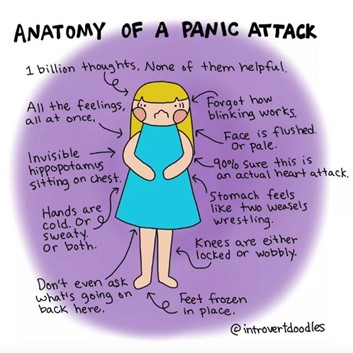Panic Disorder
Advanced Therapeutic Solutions for Anxiety provides therapy for the treatment of Panic Disorder.
A panic attack is characterized as an abrupt surge of intense fear or intense discomfort, reaching a peak within minutes. During the surge, a person having a panic attack may experience heart palpitations, chest pains, sweating, trembling, shortness of breath, feelings of choking, and/or nausea or abdominal distress. They may feel dizzy, unsteady, light-headed, or faint. They could feel chills or heat sensations, numbness or tingling sensations (paresthesias), feelings of unreality (derealization) or being detached from oneself (depersonalization). During the surge, the person may fear that they are losing control, “going crazy” or fear that they’re dying.
A panic attack is scary. The sudden surge of such intense physical and cognitive symptoms that peak within minutes may leave a person to worry that it will occur again.
While panic attacks affect 11.2% of adults (1 of 11) in the U. S., not all adults go on to develop panic disorder. Panic disorder develops when a person has recurrent unexpected panic attacks and either worries persistently that the panic attack will occur again, or go to great lengths to ensure they don’t have one, such as avoiding physical exertion. They may also plan their schedule around making sure someone is available to help, just in case an unexpected attack happens. They may fear that they will indeed lose control, go crazy, embarrass themselves, or have a heart attack.
Panic disorder affects 2-3% (about 1 of 40) adults and adolescents, with the median age of 20-24 for when panic disorders may develop. Panic attacks are rare in children, and panic disorder is even rarer, with less than .4% (or about 1 of 260) occurring in children under age 14.
Panic disorder is treated with cognitive behavioral therapy, exposure therapy, and acceptance and commitment therapy. Psychoeducation about anxiety helps to increase the person’s understanding of what a panic attack is and how the cycle runs. Learning about the thoughts-emotions connection, particularly how the fear thoughts (e.g., “I’m having a heart attack”) feed the fear, which then triggers more physical symptoms, helps the person understand how both work to feed off each other during a panic attack. During exposure therapy, the feared event (i.e., panic attack) is simulated by bringing on physical sensations such as spinning around in circles to feel dizzy or running in place to have shortness of breath, and then applying the cognitive reappraisals and progressive muscle relaxation to calm the sensations. Gaining this understanding helps a person feel more in control during a panic attack, and helps them learn how to turn off the attack before it peaks.
Clinical Procedures for Panic Disorder Evaluation and Outpatient Treatment
Free Phone Intake Consultation
Up to 30-min phone consultation so we can hear about your presenting issue, the symptoms you are experiencing, when they started, the severity of symptoms, and if we are the appropriate place for your treatment. The diagnostic intake process is discussed, and your insurance/billing questions are answered. If the treatment you need is within our scope of services, we begin the scheduling process. If it is deemed that we are not the appropriate place, we will provide you with referrals and resources to help you. We want to make sure to connect you with services, and that includes helping you find treatment elsewhere if that's what you need.
Free
CPT CODE: 0
Diagnostic Evaluation
A 90-min diagnostic interview is conducted to assess the presenting problem, symptoms severity (onset, duration, frequency), review areas of life that have been impacted (daily functioning, work, home), collect history, including family history of anxiety or depression, and review what you hope to gain from treatment at ATSA. Specific questions and or measures may be administered during the session for diagnostic purposes.
Starting at 295
CPT CODE: 90791
Treatment Planning Session
A 60-min session to review how the first sessions have felt to you, present hypotheses, and collaborate on a treatment plan. Treatment approaches may include Acceptance and Commitment Therapy (ACT), Cognitive Behavioral Therapy (CBT), Exposure and Response Prevention (ERP). Treatment dose is also discussed, specifically if weekly 60-min outpatient sessions will be effective, or if intensive doses (e.g., 3-hr sessions) should be considered. Likewise, location of where sessions should occur for most effective outcome is also discussed and planned out. Decisions are made as to whether to start with therapy sessions only, allowing for the future addition of psychopharmacological treatment as an adjunct, or whether to start with combined treatment, (or in rare cases to start with psychopharmacological treatment before CBT, ACT, or ERP).
Starting at 175
CPT CODE: 90837
Exposure Clinic Session
60 min exposure sessions to present you with the phobic stimulus and begin the process of fear extinction. The key to exposure therapy is to activate new learning, which is done by presenting the phobic stimulus, and assisting you to approach (vs avoid) the stimulus, using a hierarchical approach. With repeated exposures, you gain distress tolerance and fear extinction. Additional therapies (e.g., ACT, CBT) may be applied to keep you focused and motivated in preparation for exposures, particularly when exposures become more challenging as we move up the hierarchy. When possible, family members will be included to learn how to facilitate approach coping and reduce enabling avoidance. Our data show that when family members learn how to support you, you are more likely to maintain your treatment gains.
Starting at 175
CPT CODE: 90837
